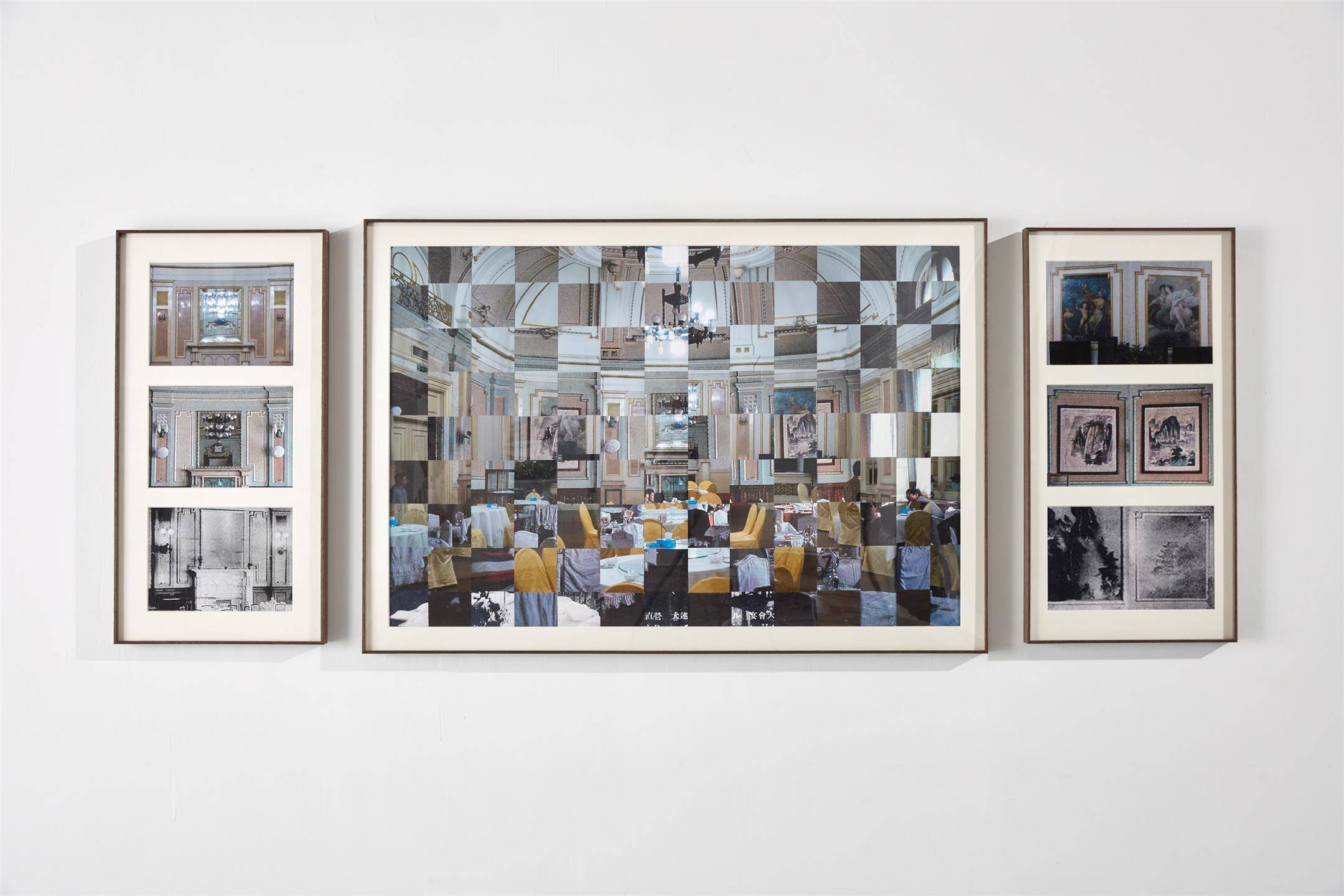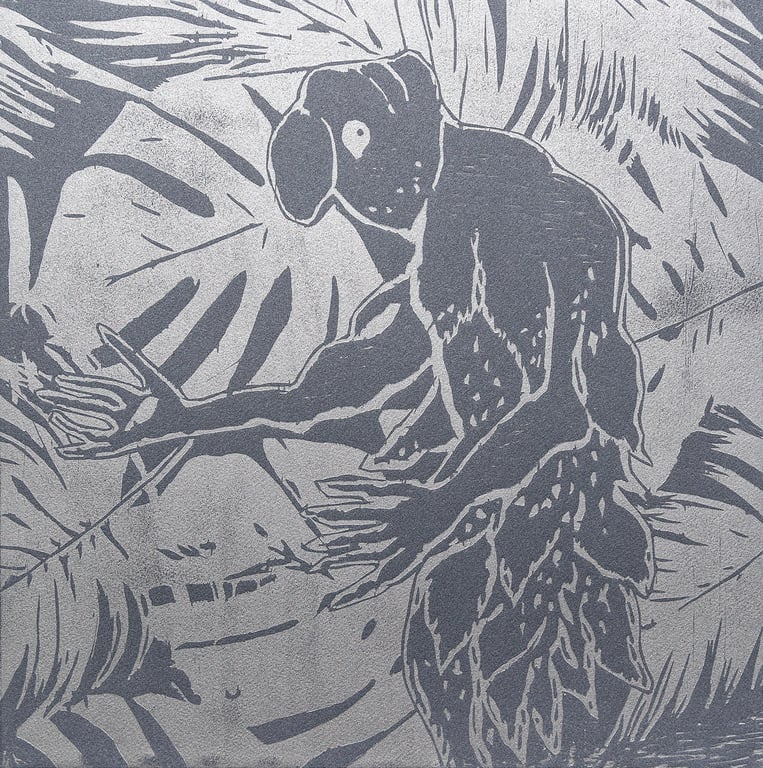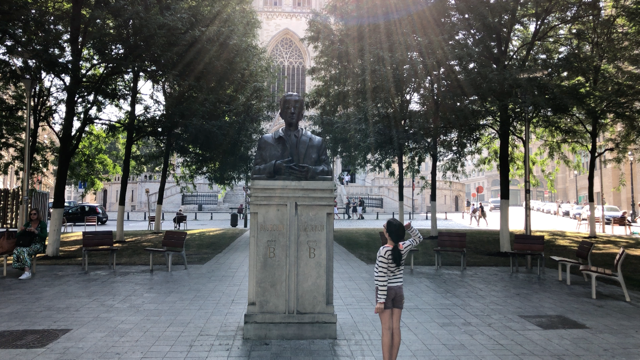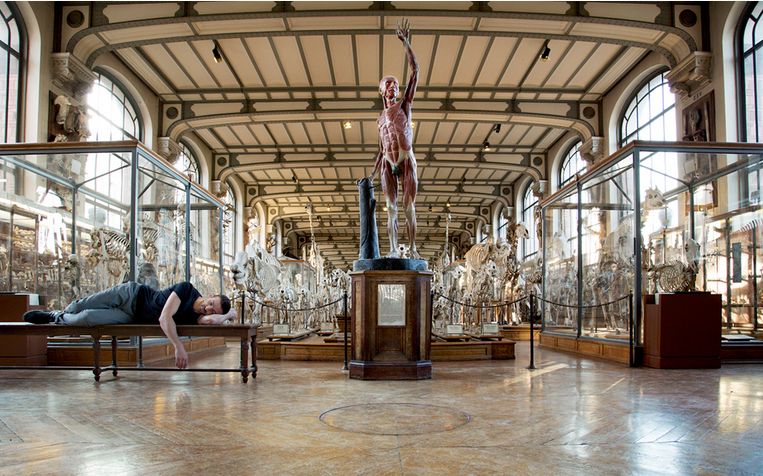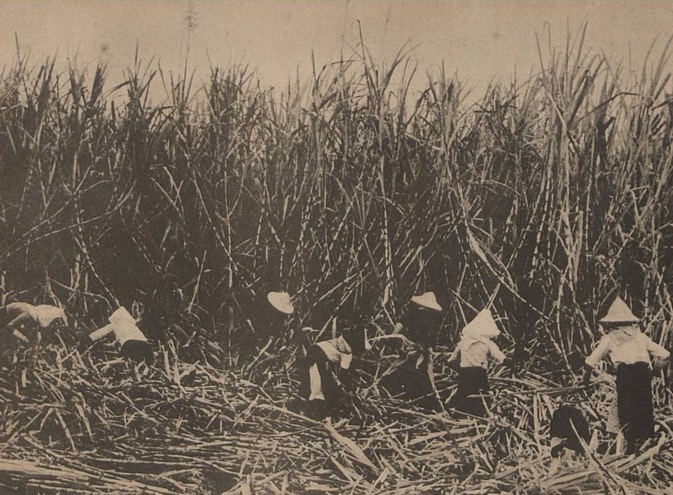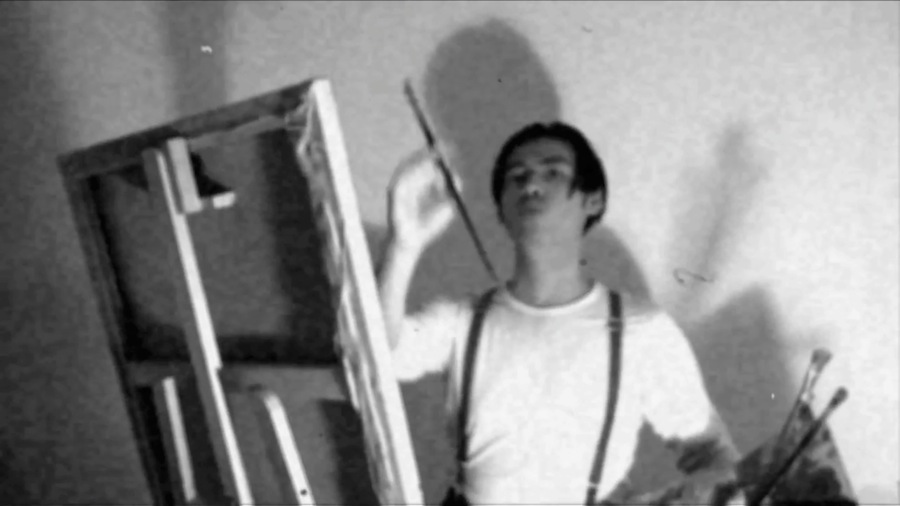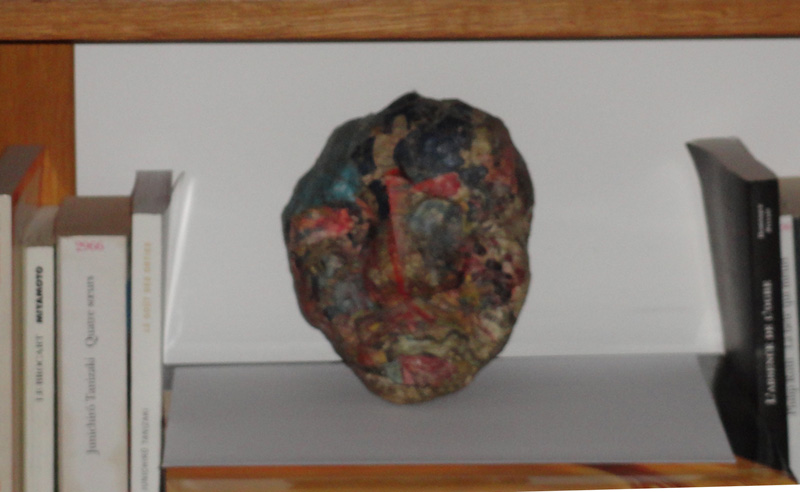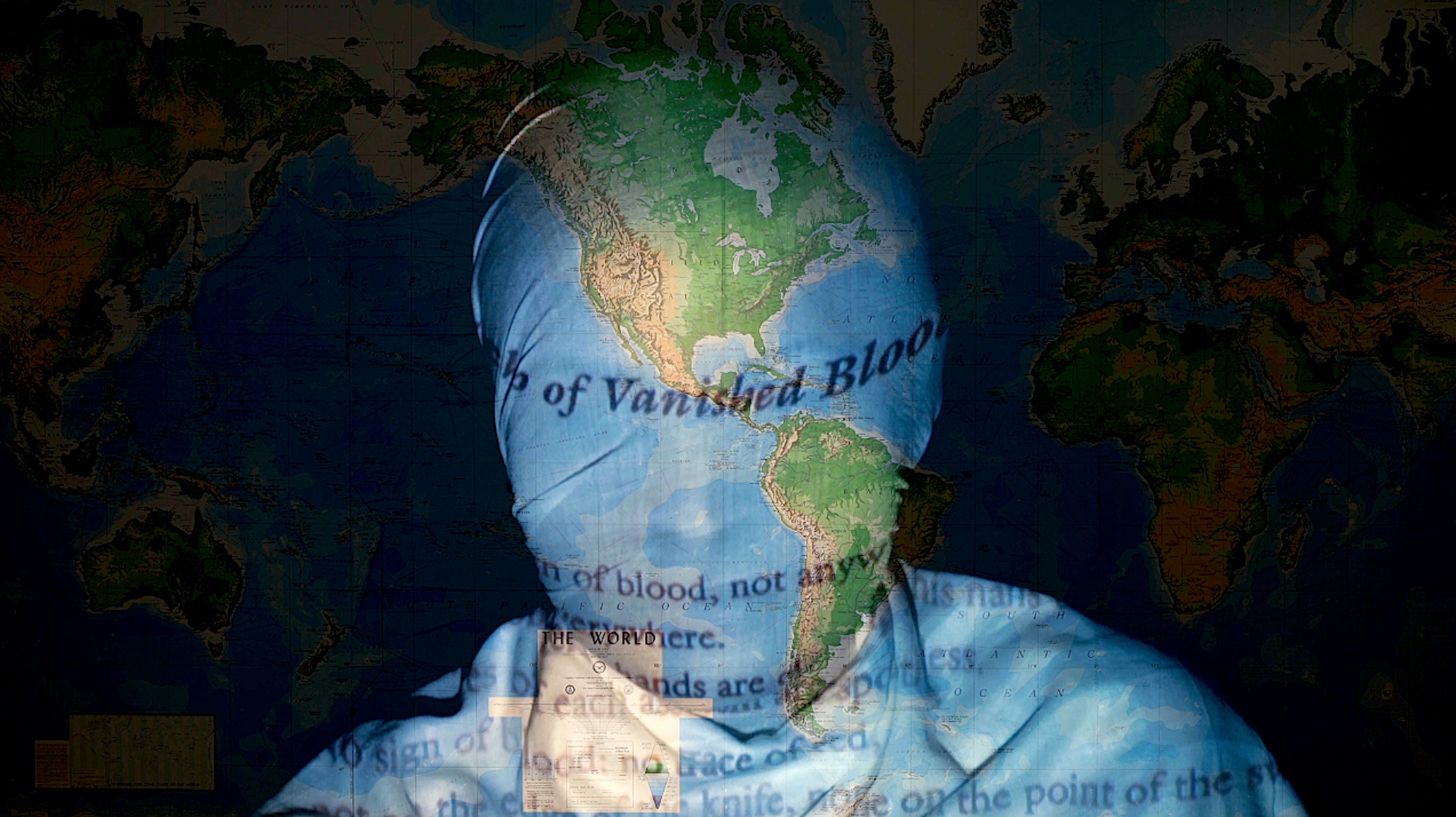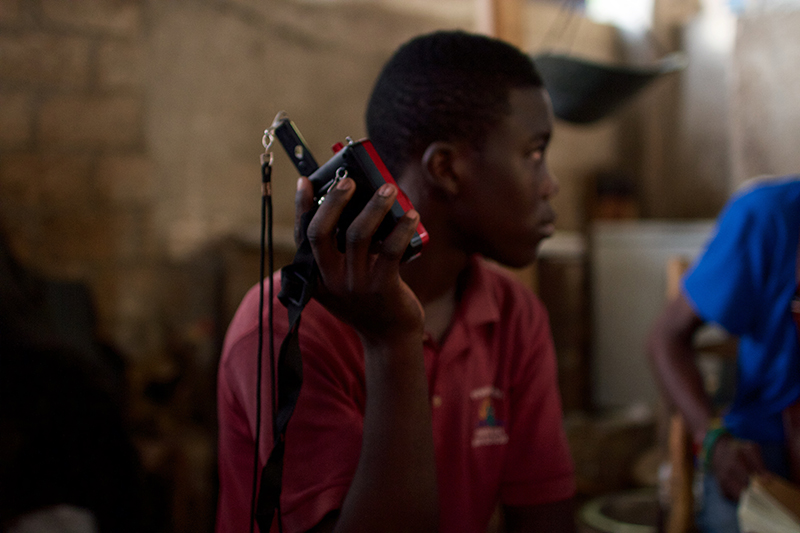
© » KADIST
Frida Orupabo
The archival images used by Frida Orupabo in her collages trace stereotyped representations of race, gender, sexuality and violence. Her works are developed through a process of decontextualization of such imagery, layering and recomposing, playing with new narratives. In this work she focuses on memory and what might be triggered in the viewer.

© » KADIST
Jesse Chun
O (for various skies) by Jesse Chun is a two-channel video sculpture that decentralizes American colonial narratives about the moon through “unlanguaging”—a methodology that the artist has conceptualized for unfixing language. The project disrupts bureaucratic documents pertaining to the United States government’s lunar colonization and militarization, such as The Lunex Project of 1958 and Project Horizon of 1959, through methods of visual, semiotic, and sonic (mis)translation and abstraction. Chun redacts the found texts, transforming them into concrete poetry, while interweaving lesser known Korean folklore about the moon, such as the precolonial Korean women’s moon dance ( ganggangsullae ) and shamanistic ritual dance for ushering the departed into another world ( gildakeum ).

© » KADIST
Nikau Hindin
Maori barkcloth making is the central artistic form in the Pacific, and still at the core of cultural expression in many Pacific countries. However, Maori barkcloth making ceased to be practiced in the nineteenth century, at the same time as the arrival of European colonists. Completed barkcloth works often represent another complex Pacific Indigenous accomplishment, the sophisticated system of celestial mapping used in the cross-Pacific navigation that led to the expansion of a vivid pan-Pacific civilisation, thriving before colonial disruption.

© » KADIST
Sandra Monterroso
Drawing & Print (Drawing & Print)
Presented as part of a recent group of works titled The Paradox of Healing, Rhombus for Healing No. 2 by Sandra Monterroso brings together several of the artist’s interests: the use of ritual and medicinal elements; the conciliation of Western and indigenous formal languages; and more recently, sewing as a recognition and celebration of her maternal lineage. The series as a whole and this painting in particular continue her interest in textiles as visual references and cultural tools to address her native Guatemala’s complex political and cultural histories.

© » KADIST
Mathieu Abonnenc
Secteur IX B is full of ghosts: some that you can see, briefly appearing at the turn of a statue in an under construction museum, some that you only dream of when you switch from day to night, of one space to another. Mathieu Kleyebe Abonnenc invites us to follow a main character, Betty, an ethnographer currently leading research in the archives of the Theodore Monod Museum for African Arts, in Dakar. Punctuated by an anguished soundtrack and borrowing tropes from thriller genre films to create a sense of oddity, the film comments on the contemporary effects of colonial legacy in cultural institutions.

© » KADIST
Abraham Oghobase
This series of photographs is inspired by the artist’s travels to Jos, Nigeria. Having grown up in the urban environment of Lagos, Abraham Oghobase was struck by the tin-mining deposits and the man-made ponds and lakes that form a dominant part of the landscape in the city of Jos and its surroundings. While visually striking, the landscape also holds a complex history, excavated by the artist, who researched the prevalent mining of tin deposits that dates back to 1904 during the British colonial mineral exploration in the Northern Protectorate.

© » KADIST
Bakudapan Food Study Group
Mooi indie (which translates to “Beautiful Indies”) is a term used to depict the beauty of nature in the East Indies during the period of Dutch colonialism in Indonesia. The term is usually used to describe a painting, romanticising the alluring tropics through the lens of European imperialism. Later in the 1950s, the prominent Indonesian painter S. Sudjojono, who is known as one of the founding fathers of Indonesian Modern Art, publicly rejected the Mooi Indie genre as Indonesian art.
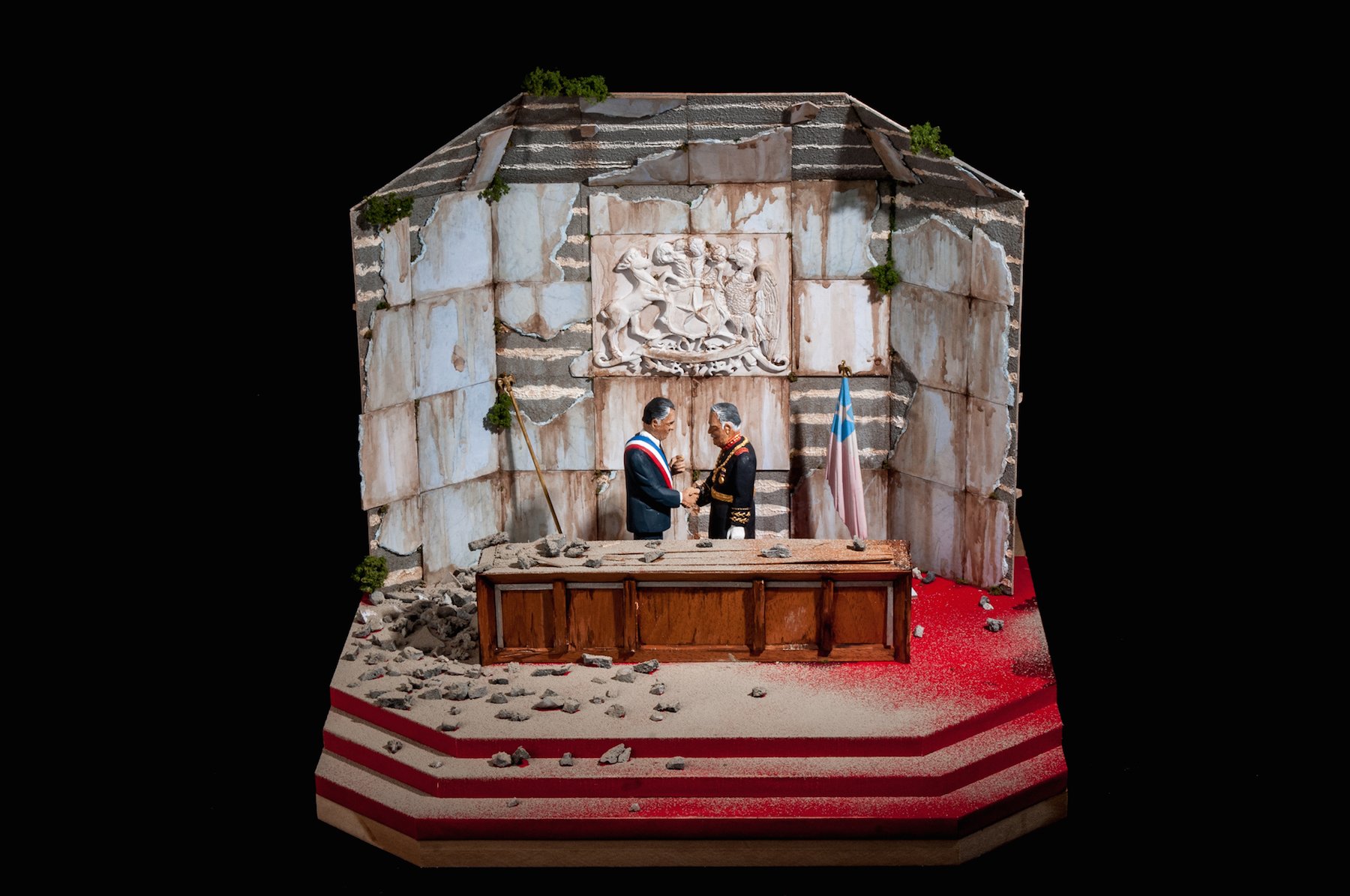
© » KADIST
Nicolás Grum
El gran pacto de Chile (The Great Pact) and La balserita de Puerto Gala (The Raft) were part of the “Museo Futuro”, an exhibition in which the artist presented nine miniature dioramas staging fragments of Chile’s history, from its colonial invasions to the present. Through the episodes he chose to depict, the artist focused on historical narratives, the way the story is told, and the supposed irrefutability of historical facts. Museo Futuro (“Future Museum”) stands within a tradition of artists who re-read history and offer their interpretation of it through the distopic lens of the museum display.

© » KADIST
Duane Linklater
silentstar, delicacy by Duane Linklater is a replica of a baby pink hoodie that the artist wore as a teenager, embellished with hand-painted elements and band patches. From associations with punk and hip-hop to skater culture, the hoodie has a history of being adopted by youth-driven communities once relegated to the fringes, and being embraced by mainstream fashion as a practical article of clothing, which Linklater’s work complicates even further. The reproduction is made with dye extracted from cochineal insects.

© » KADIST
Kiluanji Kia Henda
Redefining The Power (with Didi Fernandes) is a metaphor of how reflections on history and society during the Angolan Civil War (1975-2002) are largely ignored within the canon of history. Resulting from Kia Henda’s research on the Fortaleza de São Miguel built by the Portuguese in the 15th century in Luanda, Angola, the Redefining The Power series was created 10 years after the Angolan Civil War as a reflection on the reactivation of memory surrounding historical monuments. Through this work, the artist aims to replace the memorialized colonial heroes and war symbols through re-appropriation, determining traumatized lands as forms of resistance and pride.

© » KADIST
Daniel Boyd
Daniel Boyd’s work WTEIA3 is part of a series of paintings that reference the stick charts used by indigenous communities on the Marshall Islands. These charts were made in order to navigate the Pacific ocean by canoe and thus crucially depict ocean swell patterns. These highly individualised maps were rarely intended for mass use but instead for memorising, and transmitting between the community, the maps were not taken to sea but instead memorised in advance.

© » KADIST
Daniela Ortiz
Previously, Ortiz produced a series of photographs related to her research on the position of ‘service architecture’, the vital space given to domestic servants in the modernist architectural houses of South American upper class families. Following the same formal principal, she has developed a new series called Estat nacio . This work presents a critical point of view on the construction of a national sovereignty through speeches and laws concerning people who are not considered as citizens according to immigration legislation and the regulations affecting immigrants’ rights and freedom.

© » KADIST
Newell Harry
(Untitled) Nimoa and Me: Kiriwina Notations by Newell Harry brings together a litany of contemporary politics—mobilization around enduring racism, the legacies of Indigenous and independence struggle, and the prospects of global solidarity against neocolonialism and social injustice. Yet what makes his stance unique is his idiosyncratic ‘anarchival’ method, developed over twenty years of living, working, and gathering in and around the South Pacific. From the resulting miscellany, Harry elicits thought-provoking new connections between collected artefacts; photographs and impressions authored by himself; and items drawn from journalist, activist, and documentary archives.
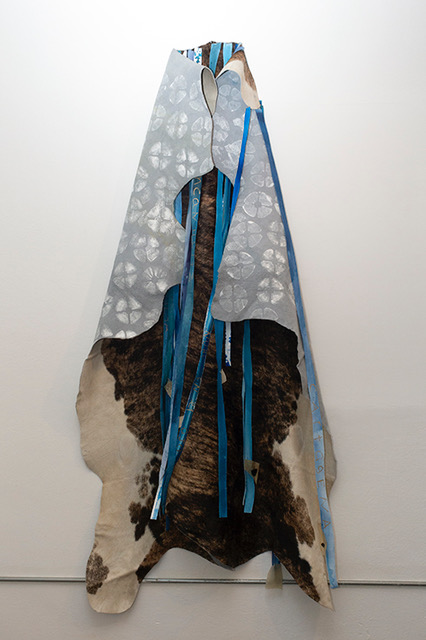
© » KADIST
Noé Martínez
As he investigates the forms that slavery took through different events that occurred during the sixteenth century in the Huasteca region of Mexico, Noé Martínez tells, in a non-linear narrative, the history of human trafficking in Relación de tráfico de personas 1525-1533 I (Study of Trafficking of Persons 1525–1533 I) . Both the departure of Huasteco Indians from the Americas, and the arrival of Africans from Cape Verde, Angola, Congo and Mozambique unravel in Martinez work as a story that has remained sealed in the colonial archives, and that continues under different guises in contemporary times. Relación de tráfico de personas 1525-1533 I is part of a series made of interventions in tanned leathers that refer to the exchange of human beings for pack animals and cattle in the Caribbean Sea.

© » KADIST
Ahmad Fuad Osman
Recollections of Long Lost Memories by Ahmad Fuad Osman is a series of 71 black and white sepia-toned archival photographs that chart, with nostalgia, the social encounters between hierarchies of life in the Malay world. It begins with British colonial rule in the mid 1800s, followed by its occupation by Japanese forces in the 1940s, the rise of Communism in the 1950s, and then the racial issues between Islamic, Chinese, and Indonesian populations in a multicultural country desiring political independence in the 1960 and 70s. The archival photographs in this series were gleaned from national archives, museums, libraries, and old books across Malaysia.

© » KADIST
Nadia Myre
First exhibited as part of the recent multidisciplinary project Code Switching and Other Work , at Art Mûr, Berlin in late 2018, Nadia Myre’s Untitled (Tobacco Barrel) takes inspiration from the cylindrical vessels used to import tobacco from North America to Europe during periods of early colonial settlement. Responding to the history of clay pipe production in the ports of London, Bristol, and Glasgow by weaving together the literal detritus of the colonial tobacco trade, Myre’s work poetically untangles material links between the British Empire, Canada, and Indigenous peoples. Following contact with the so-called New World in the 1600s, the growing popularity of tobacco use in Europe led to the design and widespread manufacturing of disposable, pre-stuffed clay tobacco pipes in Britain.

© » KADIST
Cici Wu
Unfinished Return of Yu Man Hon by Cici Wu is delicate, but physically much more robust than Cici Wu’s earlier works. What continues is the sense of longing, of something unresolved; it is haunting, like the images from a dream that we try to remember upon waking up. Unfinished Return of Yu Man Hon revolves around the story of a developmentally challenged young boy, who purportedly disappeared during the handover of Hong Kong by the British to Chinese governance.

© » KADIST
Joscelyn Gardner
Drawing & Print (Drawing & Print)
Creole Portraits III alludes to the 18th century practice by slave women on Caribbean plantations of using tropical plants as natural abortifacients. As an act of political resistance against their exploitation as “breeders” of new slaves and to protest the inhumanity of slavery, some slave women chose to either abort or kill their offspring. Armed with practical knowledge passed on orally from their African ancestors and/or Amerindian counterparts, enslaved Creole women collected the seeds, bark, flowers, sap, and roots from various plants which allowed them to secretly put an end to their pregnancies.
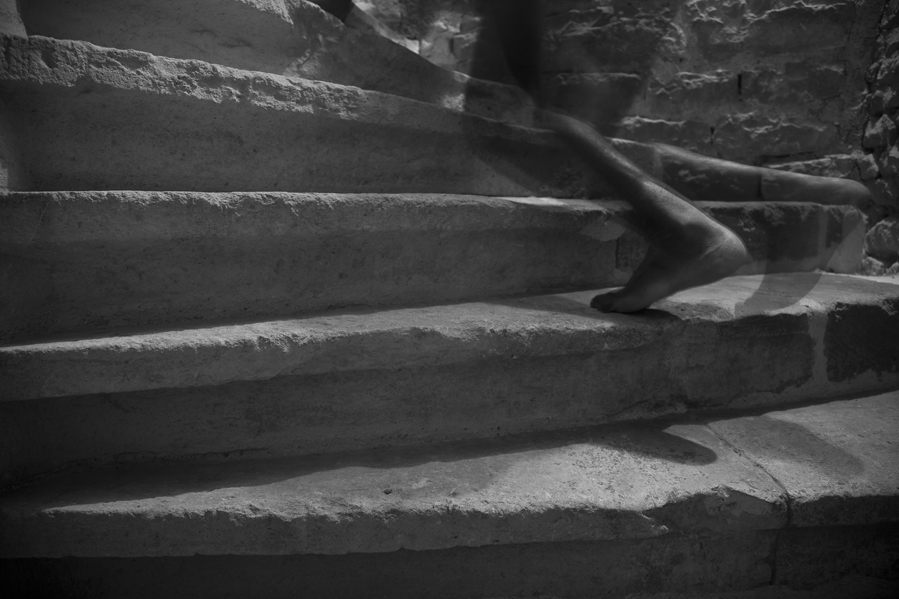
© » KADIST
Em'kal Eyongakpa
Em’kal Eyongakpa was born in Cameroon in 1981. After obtaining a postgraduate diploma in Botany and Ecology, he decided to concentrate exclusively on visual and sound art. His use of poetic, symbolic and surrealistic imagery is often sprinkled with paradoxes that challenge the obvious.

© » KADIST
Gary-Ross Pastrana
Gary-Ross Pastrana’s video installation Rewilding consists of three large-scale projections placed across the exhibition space. The poetic footage filmed by the artist portrays three interconnected worlds: a colony of termites; a piano repair workshop in the outskirts of Manila; and an empty concert theatre. Their interconnectivity is shaped by the voice-over of three narrators: a musician discussing the balance between order and chaos found in classical music; a piano repairman describing termite infestations in an instrument of European origin; and a scientist describing the unique social structures of this tropical parasite.

© » KADIST
Engel Leonardo
As with so many other colonized geographies, the ways in which violence has become a natural and expected component of Santo Domingo reflects the forced friendship between the beneficiaries and residues of Modernism. What distinguishes these two communities? What separates them?

© » KADIST
Ícaro Lira
Icaro Lira has been developing the project “Museum of the Foreigner” since 2015, in which he recounts the trajectories of populations inside Brazil, from the north to the big cities of the south. The artist is himself Nordestin and moved to Rio to study cinema before enrolling at art school. The term “museum” is ironic, it evokes the institution and with it, the official history that the artist seeks to deconstruct by creating multiple stories that intertwine.

© » KADIST
Cian Dayrit
Yuta Nagi Panaad (Promised Land) by Cian Dayrit addresses the impacts of the globalized economy and its powerful ideology on the spaces of everyday life. This tapestry work is a map that aims to visualize the expanding borders of mineral extraction, agri-business plantations, and their effects on the communities and the ecology of Mindanao, Philippines. Mindanao has a history of colonialism, exploitation and displacement of its people.
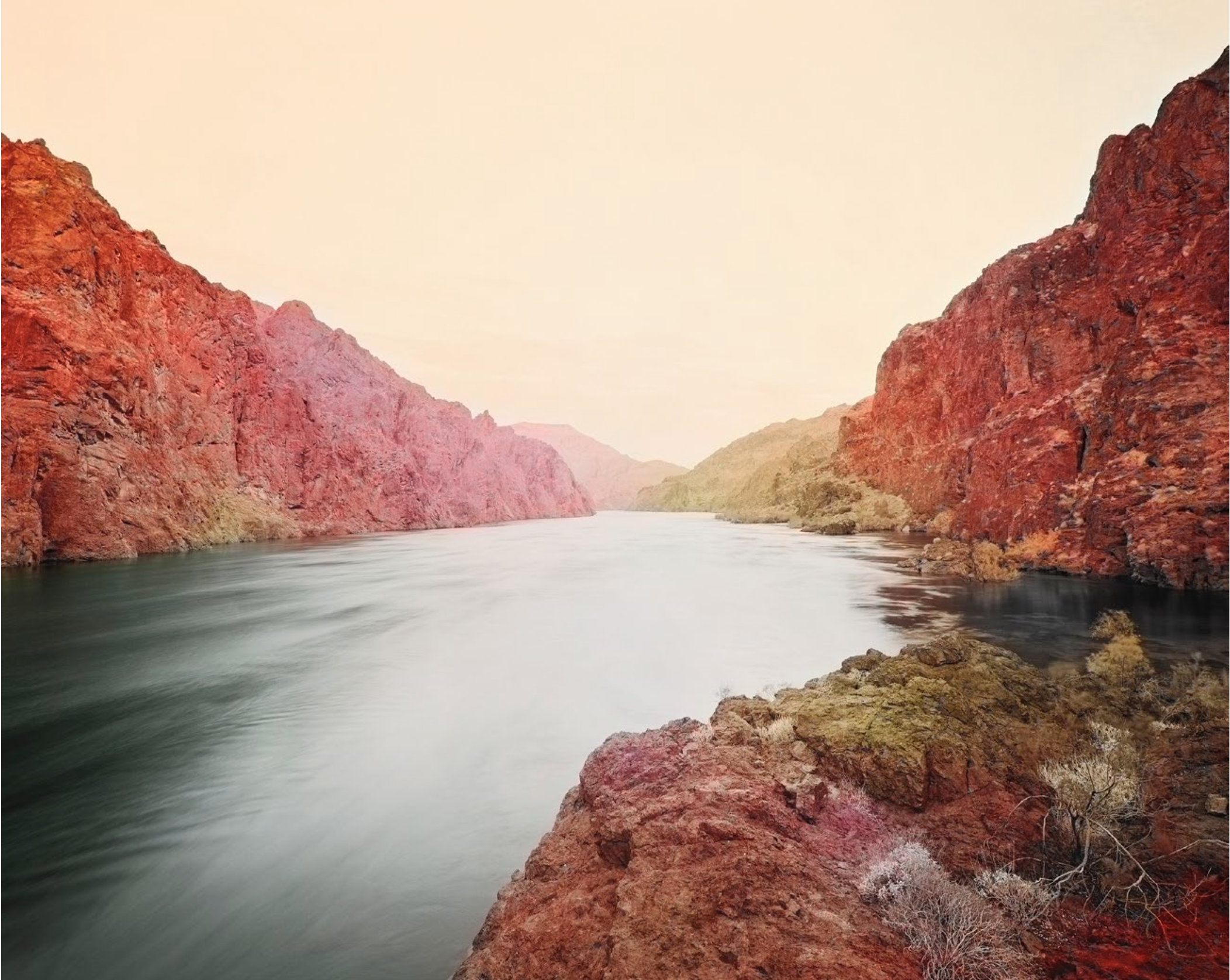
© » KADIST
Trevor Paglen
The Black Canyon Deep Semantic Image Segments by Trevor Paglen merges traditional American landscape photography (sometimes referred as ‘frontier photography’ for sites located in the American West) with artificial intelligence and other technological advances such as computer vision. In order to take this photograph, Paglen traveled to the Black Canyon, south of the Hoover Dam. Only accessible by water, Paglen piloted a boat up the Colorado river into the canyon.
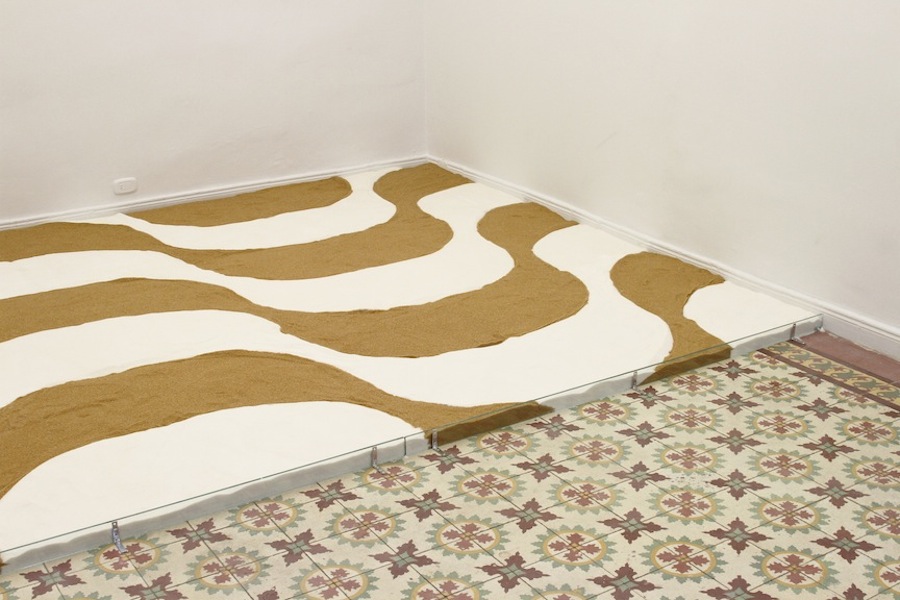
© » KADIST
Felipe Arturo
Defined as entropy, the second law of thermodynamics proposes that energy is more easily dispersed than it is concentrated. One basic illustration of entropy is to imagine white and black sand: once mixed together, it is highly unlikely that the contrasting grains of sand can be separated and restored to their original distinct color groups. Arturo’s Trópico Entrópico ( Entropic Tropics , 2012) considers the colonization of the American continent as a similarly irreversible process of cultural entropy.

© » KADIST
CAMP
The Annotated “Gujarat and the Sea” Exhibition is a collateral project within the larger body of work around the Indian Ocean, entitled “Wharfage” (2009-13) which has included over the years a radio event, several books and a film. “Boat Modes” (2009-12) dealt with the modalities of maritime life on ships and in ports between UAE, Southern Iran, India and Somalia, using photographs, texts and film based on mobile phone videos made by sailors. CAMP sees this work as a kind of historical intervention on the same subject.

© » KADIST
Danielle Dean
In True Red Ruin (Elmina Castle) , Danielle Dean uses archival documents to re-imagine colonial history from the 1400s, while also referencing her own personal history. Elmina Castle was built in Ghana in 1482 as a Portuguese trading post, and later became a key location in the Atlantic slave trade. Dean’s re-enactment is set in an affordable housing community in Houston, Texas, where her half-sister Ashstress Agwunobi lives, and who also performs the role of “the native.” Dean plays the role of “the prospector,” who plans to “colonize” her sister’s home by bringing a wobbly red cardboard castle into the grounds of the community and getting the locals to help build it and work there.

© » KADIST
Sancintya Mohini Simpson
Drawing & Print (Drawing & Print)
And words were whispered by Sancintya Mohini Simpson is a series of ten works on paper based on the lived experiences of Indian women taken to the Natal region of South Africa from the 1860s to the early 1900s to work in tea and sugarcane plantations during apartheid, which included servitude in its broadest and most sinister definition. This often-overlooked chapter in colonial history is close to the artist, as her maternal family was contracted to a sugar plantation in Natal, then one of the four British colonies in South Africa. These indentured servants, derogatorily called ‘coolies’, were employees by title, but were effectually slaves.

© » KADIST
Trevor Paglen
Half Dome Hough Transform by Trevor Paglen merges traditional American landscape photography (sometimes referred as ‘frontier photography’ for sites located in the American West) with artificial intelligence and other technological advances such as computer vision. This photograph was taken at Half Dome, a frequently visited granite rock formation in Yosemite National Park, California. For this work, Paglen created a digital file of the 8 x 10 inch photographic negative so that the artificial intelligence program can apply computer vision to evaluate the content of the image.

© » KADIST
Ximena Garrido Lecca
Destilaciones ( Distillations , 2014) is an installation composed of a group of ceramic pots, presented on the floor and within a steel structure. Copper pipes run through the perforated ceramics, evoking the design of an oil purifier. The work is a direct reference to the history of the Peruvian coastal town of Lobitos.
Abraham Oghobase
Abraham Onoriode Oghobase’s artistic practice explores identity in relation to socio-economic and historic geographies...
Ana Vaz
Ana Vaz is an artist and filmmaker whose works speculate on the relationships between self and other, and myth and history, through a cosmology of signs, references, and perspectives...
Sancintya Mohini Simpson
Sancintya Mohini Simpson is an artist, writer, and researcher whose work addresses the impact of colonization on the historical and lived experiences of her family and broader diasporic communities...
Daniela Ortiz
In order to reveal and critique hegemonic structures of power, Daniela Ortiz constructs visual narratives that examine concepts such as nationality, racialization, and social class...
Trevor Paglen
Trevor Paglen’s work combines the knowledge-base of artist, geographer and activist...
Ahmad Fuad Osman
Ahmad Fuad Osman is of a generation that came of age in a Malay world whose artists were eager to speak about socio-political issues on terms that broadened questions of nationhood, ethnicity, faith, and historical fact, doubtful of the grand narrative that had been propounded since the race riots of the late 1960s...
Nadia Myre
The work of Nadia Myre, member of the Kitigan Zibi Anishinabeg First Nation, is notable for its embrace of cross-cultural mediations as a strategy towards celebrating and reclaiming the far-reaching intellectual and aesthetic contributions of Indigenous communities...
Luka Yuanyuan Yang
Luka Yuanyuan Yang is a photographer, filmmaker and visual artist based in Beijing...
Khvay Samnang
Khvay Samnang’s work critically examines the interlocking nature of ritual and politics, the humanitarian and ecological impacts of globalization, colonialism and migration, and the cultural-material histories of exchange that have shaped the Southeast Asia region...
Natalia Lassalle-Morillo
Natalia Lassalle-Morillo’s films explore familial, neighborly, and citizen relationships in the context of Puerto Rico’s fraught history with the United States and the resulting imperialist oppression that has altered generations of families’ material and spiritual trajectories...
Shahzia Sikander
- location: New York
- location: Texas
- year born: 1969
- gender: female
- nationality: Pakistani-American
- home town: Lahore, Pakistan
Corey McCorkle
Described as a ‘spatial interventionist’, Corey McCorkle is a New York-based artist and trained architect, working in photography, architectural interventions, sculpture, installations, and films...
Leah Gordon
Leah Gordon is an artist, curator, and writer, whose work considers the intervolved and intersectional histories of the Caribbean plantation system, the Trans-Atlantic Slave Trade, the Enclosure Acts and the creation of the British working-class...
Michelle and Noel Keserwany
Michelle and Noël Keserwany compose and perform their own songs, as well as contribute to the illustrations and animations featured in the videos they produced...
Joscelyn Gardner
Joscelyn Gardner is a Caribbean / Canadian visual artist working primarily with printmaking and multimedia installation...
Musquiqui Chihying and Gregor Kasper
Through his artistic career, Musquiqui Chihying has striven to dislocate and reconstruct established modes of behavior within systems and structures of power...
Jane Jin Kaisen and Guston Sondin-Kung
Working with narrative experimental film, multi-channel video installation, performative video art, photography, and text, Jane Jin Kaisen engages themes of memory, trauma, migration and translation at the intersection of personal and collective histories...
Vvzela Kook
Vvzela Kook works in multiple media, including AV, performance, theatre, computer graphics, 3D printing, and drawing, often combining recent technology with artistic imagination and skill to navigate and describe cityscapes, their memory, connections, and hidden cybernetic structures, playing both with human sensorial perception and narrative devices...
Richard Bell
Richard Bell works across a variety of media including painting, installation, performance and video and text to pose provocative, complex, and humorous challenges to our preconceived ideas of Aboriginal art, as well as addressing contemporary debates around identity, place, and politics...
Musquiqui Chihying
Through his artistic career, Musquiqui Chihying has striven to dislocate and reconstruct established modes of behavior within systems and structures of power...
Noara Quintana
Noara Quintana’s research-based practice focuses on the materiality of everyday objects and their interconnection with sociopolitical and historical processes in the Global South...
Hank Willis Thomas
- location: New York, New York
- year born: 1976
- gender: male
- nationality: American
- home town: Plainfield, New Jersey
Runo Lagomarsino
- location: Malmo, Sweden
- location: Sao Paolo, Brazil
- year born: 1977
- gender: male
- nationality: Italian-Argentine-Swedish
- home town: Sweden
Tracey Rose
Tracey Rose, (b...
Kiluanji Kia Henda
A self-taught artist, Kiluanji Kia Henda employs a strong sense of humour in his work, which often hones in on themes of identity, politics, and perceptions of post-colonialism and modernism in Africa...
Enrique Ramirez
- year born: 1979
- gender: male
- nationality: Chilean
- home town: Santiago, Chile
Nikau Hindin
Through her art practice, Nikau Hindin revives the Maori artform of barkcloth making...
Danielle Dean
Danielle Dean creates videos that use appropriated language from archives of advertisements, political speeches, newscasts, and pop culture to create dialogues to investigate capitalism, post-colonialism, and patriarchy...
Em'kal Eyongakpa
Em’kal Eyongakpa was born in Cameroon in 1981...
Carolina Caycedo
Carolina Caycedo’s work triumphs environmental justice through demonstrations of resistance and solidarity...
-
1970-1979
Aubrey Williams
1972Carib Carnival illustrates Aubrey Willams’s unique artistic language, combining Pre-Columbian iconography with abstraction...
Antonio Ole
1978Antonio Ole’s Rhythm of N’gola Rhythms (1978), is a film about the struggle for Angolan political independence...
-
2000-2009
Tracey Rose
2001“Maqe II” is at first glance a romantic image of three diaphanous angels hovering in the luminous sky over a South African township...
Ahmad Fuad Osman
2007Recollections of Long Lost Memories by Ahmad Fuad Osman is a series of 71 black and white sepia-toned archival photographs that chart, with nostalgia, the social encounters between hierarchies of life in the Malay world...
Joscelyn Gardner
Drawing & Print
2009(Drawing & Print) Creole Portraits III alludes to the 18th century practice by slave women on Caribbean plantations of using tropical plants as natural abortifacients...
Fred Wilson
2009Fred Wilson’s flag paintings document the 20th century history of African people, indexing the period of liberation from colonialism...
-
2010-2019
Shahzia Sikander
2010The Last Post was inspired by Sikander’s ongoing interest in the colonial history of the sub-continent and the British opium trade with China...
Jane Jin Kaisen and Guston Sondin-Kung
2010The Woman, The Orphan, and The Tiger begins with the sound of women’s voices describing histories of violence, of things repressed and silenced...
Engel Leonardo
2011As with so many other colonized geographies, the ways in which violence has become a natural and expected component of Santo Domingo reflects the forced friendship between the beneficiaries and residues of Modernism...
Kiluanji Kia Henda
2011Redefining The Power (with Didi Fernandes) is a metaphor of how reflections on history and society during the Angolan Civil War (1975-2002) are largely ignored within the canon of history...
Hong-Kai Wang
2011The video Music While We Work (2011) is the first part/work of a long-term research project started in 2010...
Felipe Arturo
2012Defined as entropy, the second law of thermodynamics proposes that energy is more easily dispersed than it is concentrated...
Ícaro Lira
2012Icaro Lira has been developing the project “Museum of the Foreigner” since 2015, in which he recounts the trajectories of populations inside Brazil, from the north to the big cities of the south...
Leah Gordon
2012The Caste Portraits Series by Leah Gordon investigates the practice of grading skin color from black to white, which marked the extent of racial mixing in 18th century Haiti...
Tom Nicholson
2012Tom Nicholson’s Comparative Monument (Palestine) engages a peculiar Australian monumental tradition: war monuments that bear the name “Palestine”...
Nandan Ghiya
2012The Chair (2012) foregrounds media-based tensions between analog and digital imaging technologies as a means of challenging the continued circulation of visual ephemera from India’s colonial past...
Nalini Malani
2012Malani draws upon her personal experience of the violent legacy of colonialism and de-colonization in India in this personal narrative that was shown as a colossal six channel video installation at dOCUMENTA (13), but is here adapted to single channel...
Daniela Ortiz
2013Previously, Ortiz produced a series of photographs related to her research on the position of ‘service architecture’, the vital space given to domestic servants in the modernist architectural houses of South American upper class families...
Yee I-Lann
2013Sarcastically titled to call attention to the problematic notions underlying colonialism, this photograph shows hundreds of Native Malaysians seated quietly behind one of their colonial oppressors...
Rometti Costales
2013This anarchist flag is made from Huayruro seeds, a native plant of South and Central American tropical areas...
Beatriz Santiago Muñoz
2013Another curious element is that it seemed that I was seeing images from the dreams I had that afternoon...
Nicolás Grum
2014El gran pacto de Chile (The Great Pact) and La balserita de Puerto Gala (The Raft) were part of the “Museo Futuro”, an exhibition in which the artist presented nine miniature dioramas staging fragments of Chile’s history, from its colonial invasions to the present...
Ximena Garrido Lecca
2014Destilaciones ( Distillations , 2014) is an installation composed of a group of ceramic pots, presented on the floor and within a steel structure...
Hank Willis Thomas
2014South Africa Righteous Space by Hank Willis Thomas is concerned with history and identity, with the way race and ‘blackness’ has not only been informed but deliberately shaped and constructed by various forces – first through colonialism and slavery, and more recently through mass media and advertising – and reminds us of the financial and economic stakes that have always been involved in representations of race....
Thu Van Tran
2014From Green to Orange is a series of silver films immersed in a bath of dye and rust...
Khvay Samnang
2014The video Rubber Man continues exploring issues related to land use, also noticeable in his Untitled series (2011)...
Nicolás Grum
2014El gran pacto de Chile (The Great Pact) and La balserita de Puerto Gala (The Raft) were part of the “Museo Futuro”, an exhibition in which the artist presented nine miniature dioramas staging fragments of Chile’s history, from its colonial invasions to the present...
Newell Harry
2015(Untitled) Nimoa and Me: Kiriwina Notations by Newell Harry brings together a litany of contemporary politics—mobilization around enduring racism, the legacies of Indigenous and independence struggle, and the prospects of global solidarity against neocolonialism and social injustice...
Mathieu Abonnenc
2015Secteur IX B is full of ghosts: some that you can see, briefly appearing at the turn of a statue in an under construction museum, some that you only dream of when you switch from day to night, of one space to another...
Carolina Caycedo
2015Carolina Caycedo’s practice conveys her very personal passion and relationship to water, as a powerful necessity and spiritual reminder...
Naresh Kumar
Drawing & Print
2015(Drawing & Print) “Relation between Black and blood” explores the connection between performance, installation and representation...
Beatriz Santiago Muñoz
2015Marché Salomon by Beatriz Santiago Muñoz depicts two meat vendors, a young man and woman, chatting in Marché Salomon, a busy Port-au-Prince market...
Matthew Angelo Harrison
2015In Hole #1 a zebra scull stands in as a representation of Africa, while the plexiglass box and the hole made through it represent the inaccessibility of that culture to African-Americans....
Naufus Ramírez-Figueroa
2015Naufus Ramírez-Figueroa’s performance Illusion of Matter establishes a dream state through a composition of motifs that were drawn from the artist’s childhood memories...
Gaëlle Choisne
2015Entre Chien et Loup is an installation incorporating a variety of media: rubber, discs, feathers and confetti that the artist weaves, sews and glues together...
Isadora Neves Marques
2016The Pudic Relation between Machine and Plant shows a looped scene where a robotic hand touches a “sensitive plant” — Mimosa Pudica, a species characteristic for closing on itself when touched...
Nohemí Pérez
Drawing & Print
2016(Drawing & Print) A rich and isolated region, El Catatumbo is located near the border with Venezuela...
Corey McCorkle
2016Corey McCorkle’s 2016 installation Pendulum is developed around the Cavendish family and their role in importing bananas to Europe...
Daniel Boyd
2017Daniel Boyd’s work WTEIA3 is part of a series of paintings that reference the stick charts used by indigenous communities on the Marshall Islands...
Danielle Dean
2017In True Red Ruin (Elmina Castle) , Danielle Dean uses archival documents to re-imagine colonial history from the 1400s, while also referencing her own personal history...
Ali Cherri
2017As a discipline born at the same time as colonialism, archeology is struggling to rid itself of this sad context...
Bady Dalloul
Drawing & Print
2017(Drawing & Print) The Great Game is a series of works composed of a number of card combinations illustrated by the faces of key political figures shaping the geopolitical landscape in the Middle East...
Santiago Yahuarcani
Drawing & Print
2017(Drawing & Print) The series Castigos del caucho by Santiago Yahuarcani originates in the oral memory transmitted by the artist’s grandfather, who was a survivor of the Putumayo genocide where thousands of Indigenous people were annihilated and enslaved to extract rubber from the Amazon forest between 1879 and 1912...
Sky Hopinka
2017Dislocation Blues by Sky Hopinka is a portrait of the 2016 Standing Rock protests against the Dakota Access Pipeline in South Dakota...
Antonio Pichillá
2017Wind by Antonio Pichillá is a textile piece depicting the glyph that represents the element wind in the Mayan tradition...
Jorge González
2017Easy to fold and carry, Jorge González’s Banquetas Chéveres (Chéveres Stools) embody the nomadic and flexible nature of the Escuela de Oficios...
Michael Rakowitz
2017The Ballad of Special Ops Cody by Michael Rakowitz is a serio-comic stop motion animated film in which an everyday African-American G...
Frida Orupabo
2018The archival images used by Frida Orupabo in her collages trace stereotyped representations of race, gender, sexuality and violence...
Nadia Myre
2018First exhibited as part of the recent multidisciplinary project Code Switching and Other Work , at Art Mûr, Berlin in late 2018, Nadia Myre’s Untitled (Tobacco Barrel) takes inspiration from the cylindrical vessels used to import tobacco from North America to Europe during periods of early colonial settlement...
Gary-Ross Pastrana
2018Gary-Ross Pastrana’s video installation Rewilding consists of three large-scale projections placed across the exhibition space...
Cian Dayrit
2018Yuta Nagi Panaad (Promised Land) by Cian Dayrit addresses the impacts of the globalized economy and its powerful ideology on the spaces of everyday life...
Abraham Oghobase
2018This series of photographs is inspired by the artist’s travels to Jos, Nigeria...
Bakudapan Food Study Group
2018Mooi indie (which translates to “Beautiful Indies”) is a term used to depict the beauty of nature in the East Indies during the period of Dutch colonialism in Indonesia...
Abraham Oghobase
2018This series of photographs is inspired by the artist’s travels to Jos, Nigeria...
Juan Brenner
2018The photographic series Tonatiuh (The Son of the Sun) by Juan Brenner is an in-depth visual study of current Guatemalan society from the perspective of miscegenation and the incalculable consequences of the Spanish conquest...
Kathy Jetnil-Kijiner
2018Anointed by Kathy Jetnil-Kijiner and Dan Lin is a poem recital/video that addresses the American nuclear testing legacy in the Marshall Islands that occurred between 1946 to 1958 in Bikini and Enewetak Atolls...
Carla Zaccagnini
2018De sino à sina (From Bell to Fate) is a six-channel sound installation by Carla Zaccagnini exploring the relationship between modern Brazil and its colonial past...
Sofía Córdova
2018dawn chorus ii: el niagara en bicicleta is a work produced in Sofía Córdova native Puerto Rico and was largely shaped by the financial crisis, the islands’ histories under colonial rule and most recently, the climate-change related natural disasters which have affected the island...
Fabien Giraud & Raphael Siboni
2018– In which an intelligence going back to its place of origin discovers the agony of gods on which it thrives – Seventh and last episode of The Unmanned , “a flood” is set in 1542 as the first conquistadors enter the land later to be known as the Silicon Valley...
Abraham Oghobase
2018This series of photographs is inspired by the artist’s travels to Jos, Nigeria...
Christian Nyampeta
2018The film Sometimes It Was Beautiful by Christian Nyampeta poetically addresses the systemic conditions leading and emerging from the 1994 Rwandan genocide, which had lasting and profound effects on Rwanda and neighbouring countries like Congo...
Dale Harding
2018Dale Harding’s installation Body of Objects consists of eleven sculptural works that the artist based on imagery found at sandstone sites across Carnarvon Gorge in Central Queensland...
Jota Mombaça
2018The performance title A Gente Combinamos De Não Morrer (BANDEIRA #1) / Us Agreed Not To Die (FLAG #1) is taken from a short story by Brazilian writer Conceição Evaristo, whose work addresses violence, resilience, and necropolitics with an Afro-diasporic lens...
Bayrol Jiménez
2018Sombras de los Valles (Shadows of the Valleys) is part of a series of works created by Bayrol Jiménez in which he is influenced by hand-painted signs and large billboards in Mexico...
Abraham Oghobase
2018This series of photographs is inspired by the artist’s travels to Jos, Nigeria...
Karrabing Film Collective
2018The Mermaids, or Aiden in Wonderland by Karrabing Film Collective is a surreal exploration of Western toxic contamination, capitalism, and human and non-human life...
Noé Martínez
2019As he investigates the forms that slavery took through different events that occurred during the sixteenth century in the Huasteca region of Mexico, Noé Martínez tells, in a non-linear narrative, the history of human trafficking in Relación de tráfico de personas 1525-1533 I (Study of Trafficking of Persons 1525–1533 I) ...
Sancintya Mohini Simpson
Drawing & Print
2019(Drawing & Print) And words were whispered by Sancintya Mohini Simpson is a series of ten works on paper based on the lived experiences of Indian women taken to the Natal region of South Africa from the 1860s to the early 1900s to work in tea and sugarcane plantations during apartheid, which included servitude in its broadest and most sinister definition...
Shubigi Rao
2019Named after a book that artist Shubigi Rao read growing up, The Yellow Scarf explores the history of the Thuggee cult in India in relation to the colonial British administration that ‘discovered’ but also ultimately exterminated this cult of assassins...
Karla Dickens
2019Karla Dickens’s collage Beneath the skim board addresses issues of discrimination and racism towards Indigenous communities in Australia through a constellation of historical and current events...
Musquiqui Chihying and Gregor Kasper
2019Addressing the legacy of colonialism, The Guestbook by Musquiqui Chihying and Gregor Kasper is a slow-paced, black-and-white film exploring the German colony of Togoland, now the Republic of Togo...
Guy Woueté
2019The video installation Le Fou Postcolonial Insane by Guy Woueté is a series of five videos that examine the concept of insanity in the post-colonial Democratic Republic of Congo...
Luka Yuanyuan Yang
2019Composed of three photographic panels, Three Times at Yamato Hotel by Luka Yuanyuan Yang is a part of the artist’s ongoing project Dalian Mirage , a seven act play in a theatre staged as the city of Dalian...
Claudia Martínez Garay
2019escenario chacana by Claudia Martínez Garay is a sculptural work composed of a frame-like structure that contains a series of ceramic pieces...
Natalia Lassalle-Morillo
2019In her film Retiro (2019), Natalia Lassalle-Morillo considers how women pass down memories to their kin as they age...
Nidhal Chamekh
Drawing & Print
2019(Drawing & Print) Nos visages ( Our Faces ) continues Nidhal Chamekh’s research around visual souvenirs of figures of the past and the light they might shed on our contemporary era...
Musquiqui Chihying
2019The Sculpture by Musquiqui Chihying comprises a two-channel lecture performance and a photograph...
Noara Quintana
2019The series Belle Époque of the Tropics by Noara Quintana has as its background the history of the rubber industrialization in North of Brazil...
Vvzela Kook
2019Columbus of Horticulture stems from Vvzela Kook’s ongoing research into the central and often-ignored role that botany played in the history of European imperialism...
-
2020-2029
Duane Linklater
2020silentstar, delicacy by Duane Linklater is a replica of a baby pink hoodie that the artist wore as a teenager, embellished with hand-painted elements and band patches...
Trevor Paglen
2020The Black Canyon Deep Semantic Image Segments by Trevor Paglen merges traditional American landscape photography (sometimes referred as ‘frontier photography’ for sites located in the American West) with artificial intelligence and other technological advances such as computer vision...
Trevor Paglen
2020Half Dome Hough Transform by Trevor Paglen merges traditional American landscape photography (sometimes referred as ‘frontier photography’ for sites located in the American West) with artificial intelligence and other technological advances such as computer vision...
Runo Lagomarsino
2020Yo también soy humo (I am also smoke) is a 16mm film that has been digitized to video...
Caroline Déodat
2020Landslides is a cinematographic essay/poem by Caroline Déodat in which fictional images are the result of research into the memories of a Mauritian dance born during colonial slavery, the Sega...
Jesse Chun
2021O (for various skies) by Jesse Chun is a two-channel video sculpture that decentralizes American colonial narratives about the moon through “unlanguaging”—a methodology that the artist has conceptualized for unfixing language...
Nikau Hindin
2021Maori barkcloth making is the central artistic form in the Pacific, and still at the core of cultural expression in many Pacific countries...
Sancintya Mohini Simpson
2021Dhuwã (term used by indentured people of Natal for ‘smoke’), is a single-channel film by Sancintya Mohini Simpson that traces back to the lived experiences of indentured labourers taken from India to Natal (now KwaZulu-Natal, South Africa) to work on sugar plantations during the late 1800s and early 1900s...
Pangrok Sulap
Drawing & Print
2021(Drawing & Print) All Nations are Created Special is a black and white woodcut print by the artist collective Pangrok Sulap...
Kent Chan
2021Heat Waves by Kent Chan examines the contexts, politics, and proliferation of the different aesthetics of heat by drawing from the aesthetics of regions defined by hot and humid climates and associated with histories of coloniality such as ‘the global south’ and the ‘developing world’...
Daniela Ortiz
2021The Rebellion of Roots by Daniela Ortiz depicts a series of situations in which tropical plants, held hostage in the botanical gardens and greenhouses of Europe, are protected and nurtured by the spirits of racialized people who died as a result of European racism...
Richard Bell
2022For Richard Bell, art is not simply a vehicle through which to represent and convey political content...
Michelle and Noel Keserwany
2022Les Chenilles by Michelle and Noël Keserwany is a sensual film that translates the source of women’s oppression into the means for their liberation...
Yuyan Wang
2022The Moon Also Rises by Yuyan Wang comprises a one-channel video and light installation...
Ana Vaz
2022Ana Vaz describes her film É Noite na América (It is Night in America) as an eco-terror tale, freely inspired by A cosmopolitics of animals by Brazilian philosopher Juliana Fausto; in which she investigates the political life of non-human beings and questions the modern idea of the exceptionality of the human species...
Jota Mombaça
2022Ghost 1: Drowning is not a poem but is not not a poem either by Jota Mombaça is part of a series of sculptures exploring water’s restless, elemental properties and what the artist describes as “the radicality of sinking”...
Sandra Monterroso
Drawing & Print
2023(Drawing & Print) Presented as part of a recent group of works titled The Paradox of Healing, Rhombus for Healing No...



